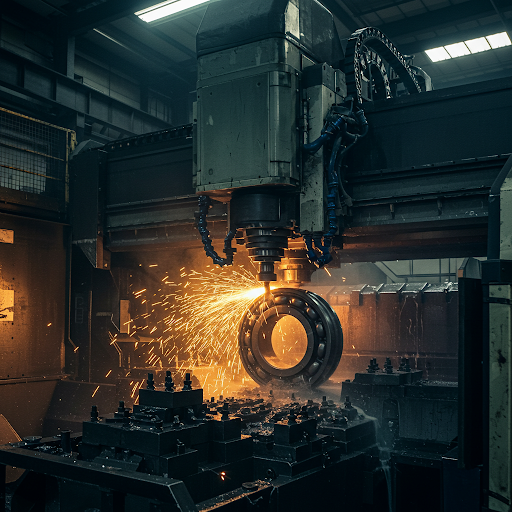Raw Material Handling
At Active Steel Forge, we recognize that the foundation of…

At Active Steel Forge, we recognize that the foundation of…

At Active Steel Forge, we offer advanced heating facilities designed…

Experience unmatched cutting precision and efficiency with our advanced cutting…

At Active Steel Forge, our advanced forging facilities offer unmatched…

At Active Steel Forge, we specialize in providing advanced heat…

Experience unmatched precision and superior quality with our advanced CNC…

10 min Read
In the realm of heavy machinery, where colossal forces are at play and reliability is paramount, high-quality bearings stand as unsung heroes. These seemingly simple components are the linchpins of smooth, efficient, and enduring operation, enabling everything from construction equipment and mining machinery to wind turbines and industrial robots to function flawlessly.
This article delves into the intricate journey of crafting these critical components, exploring the meticulous processes and advanced technologies that contribute to their exceptional performance.
1. A Foundation of Excellence: Selecting Superior Materials
The journey begins with a meticulous selection of raw materials. High-performance bearings demand materials that exhibit exceptional strength, durability, and resistance to the rigors of heavy-duty applications.
2. Forging: Shaping Strength and Structure
The forging process is where the true transformation begins. The carefully selected raw material is subjected to intense heat, softening it for the subsequent shaping phase. Immense pressure is then applied, forging the material into the desired shape. This is not merely about shaping; it’s about refining the very structure of the metal.
3. Machining and Grinding: Precision in Every Detail
Following the forging process, the components undergo meticulous machining operations. Turning, milling, and grinding are employed to achieve the exacting dimensions and surface finishes required for optimal performance.
4. Heat Treatment: Hardening and Tempering
To further enhance the performance characteristics, the components undergo a rigorous heat treatment process:
5. Assembly: Precision and Cleanliness
The individual components – inner and outer rings, rolling elements (balls or rollers), and separators – are then assembled into a complete bearing unit. This is a delicate process that requires meticulous attention to detail and meticulous cleanliness. Any contamination introduced during assembly can significantly impact the bearing’s performance and longevity.
6. Quality Control: Rigorous Testing and Inspection
Throughout the manufacturing process, rigorous quality control measures are implemented at every stage. This ensures that each bearing meets the stringent performance standards required for demanding heavy machinery applications.
7. Lubrication: The Lifeblood of Bearing Performance
Proper lubrication is crucial for optimal bearing performance. High-quality lubricants, such as specialized greases or oils, minimize friction, reduce wear and tear, and dissipate heat generated during operation. The selection of the appropriate lubricant is critical and depends on various factors, including the operating environment, the type of bearing, and the specific application requirements.
8. Advanced Technologies: Driving Innovation
The manufacturing of high-quality bearings is constantly evolving, driven by advancements in technology:
Conclusion
The production of high-quality bearings for heavy machinery applications is a testament to human ingenuity and technological advancement. From the careful selection of raw materials to the meticulous application of advanced manufacturing techniques, every step is crucial in ensuring the creation of components that can withstand the rigors of demanding applications.
These seemingly simple components are crucial to the smooth and efficient operation of countless industries, from construction and mining to renewable energy and aerospace. As technology continues to advance, so too will the sophistication and performance of these critical components, driving innovation and progress across a wide range of industries.
Get in touch with our experts today
